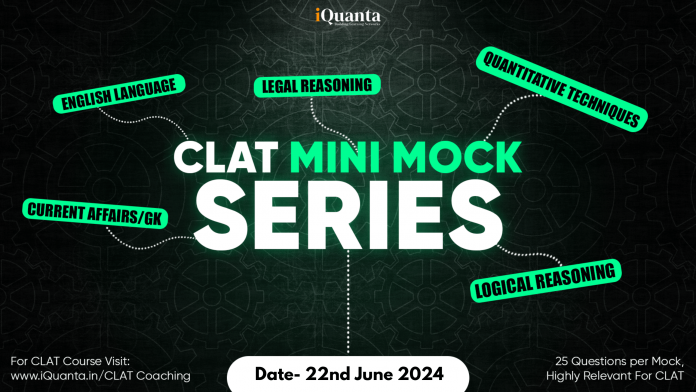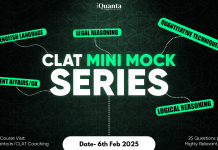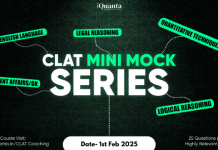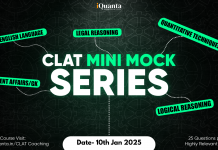iQuanta has launched a Mini Mock Series covering all the sections of the CLAT exam, these questions have been handpicked by our faculty based on the latest CLAT exam pattern.
Instructions:-
1. Attempt all the questions.
2. Once you have completed all the questions of a particular section click on the submit button for scores and explanations then move to the next sections.
3. For each correct answer, you receive 1 mark. For this mock, there is no negative marking.
English Language
Directions: Read the passage and answer the following question.
I came across a study from the New England Journal of Medicine (2018) that found that the most productive age in a human’s life is not your 20s or 30s, but 60 to 70. And, the study confirms that the second most productive age is between 70 and 80 and the third most productive decade is 50 to 60.
What is going on here? Is this another disinformation campaign by the oldies among us, trying to vindicate their creaking joints, swollen knees, aching backs and greying hair by purveying fake news about their superiority to the fit, energetic, six-pack-sporting, young whippersnappers who are actually producing everything that matters in the world?
Not quite. Consider the evidence: The average age of a Nobel Prize winner is 62. The average age of a CEO in a Fortune 500 company is 63. The average age of popes is 76. And, in India, the average age of the cabinet is 60. Our prime minister, at 69, is a mere juvenile compared with some of his predecessors, such as Morarji Desai, who became PM at 81, or even the much-maligned Jawaharlal Nehru, who died in office at 74.
Looking back at my own life, next month I will publish my 20th book. Ten of those have seen the light of print since after my 50th birthday. There is little doubt that I have been more productive in my sixth and now seventh decade than in my (at least partially) misspent youth.
There is a logical reason for this. It is true that when you are young you are still feeling your way, acquiring the skills you need and laying the foundations of your future achievements. Most of our 20s and 30s are spent on romance, on wooing our future partner, and in creating and bringing up our family. The responsibility of making a living, of educating our children, and of taking care of our parents is a time-consuming one that inevitably distracts us from a single-minded focus on professional accomplishment.
In other words, most people’s social and personal circumstances mean that their lives are so designed that the best years of their existence are between 60 and 80. That is the age when they have acquired whatever skills they are likely to acquire, have made (and learned from) their mistakes, and can focus on sharpening and deploying those skills. Thanks to modern medicine, most people are able to remain reasonably healthy past 60 and, even if physically slower, remain capable of top-quality intellectual performance. It is an age when there are fewer distractions. It is the time when you can do your best work.
Current Affairs and General Knowledge
Directions: Read the passage and answer the following question.
About a decade ago, New Delhi-based entrepreneur Jai Dhar Gupta became a clean air activist when he was diagnosed with bronchial asthma. His motive was to spread knowledge about the need to ensure our cities breathe easy. He was also on the air pollution think tank of the Delhi Government (wherein he helped bring into effect the odd-even rule for vehicles).
Over the past few years, Jai has been working on yet another project: creating India’s first biosphere within a tiger reserve. “Rajaji Raghati Biosphere (RRB) is a 35-acre private forest initiative led by ecologist Vijay Dhasmana, who is known for restoring the Aravalli landscapes, and me. We have identified rare and endangered species of native trees and are attempting to revive them, and protect the area from poachers and mining,” says the 51-year-old.
Legal Reasoning
Directions: Read the passage and answer the following question.
The Transgender Persons (Protection of Rights) Act, 2019 was passed by Parliament on November 26, 2019. The Bill defines a transperson as someone whose gender does not match the one assigned at birth. It prohibits discrimination against them in employment, education, housing, healthcare and other services. A grievance redressal mechanism has been set up for the issues related to transgenders called National Council for Transgender Persons (NCTP) for the protection of their rights. Any complaint regarding discrimination such as restriction to entry shall be raised with the NCTP.
The Bill allows self-perception of gender identity, but it mandates that each person would have to be recognised as ‘transgender’ on the basis of a certificate of identity issued by a district magistrate. Under the provisions of this 2019 Act, a transgender person can apply to the District Magistrate for a transgender person certificate which will give them the right to change the name on their birth certificate and have all documents updated accordingly. However, similar to the 2018 bill’s provisions, a transgender person can be identified as male or female only after applying for a revised certificate to the District Magistrate, post sex reassignment surgery.
The Bill enforces a minor’s right of residence compelling any transperson below 18 to cohabit with their natal family. Every transgender child has a Right of Residence with parents and immediate family members and be included in the household. This ensured a family-life for transgender children by prohibiting their separation from their family, without taking into account harassment and discrimination they may face within their family as a result of which they may choose to be separated and reside with transgender persons. A transgender child, as per the provisions, could be separated from their family only by a court order.
The bill further criminalises begging which transgender persons in India, such as the hijras and jogtas, engage in as a ritual-custom, while some rely on it for livelihood.
The 2019 Act also protects transgender children and provides for states and institutions to come up with adequate policies for the welfare of transgender persons. However, unlike the Rights of Transgender Persons Bill, 2014, neither the 2018 nor the 2019 Act provides for mandatory reservations for transgender persons in educational institutions and jobs. The 2014 bill had provided for two per-cent reservations in educational institutions and public employment. Similar to the 2018 bill, the 2019 Act provides for punishment for crimes against transgender persons, which stands as an imprisonment for a term not less than six months, but which may extend to two years and a fine. Both bills also provide for the constitution of a National Council for Transgender Persons.
[Extracted with edits and revision from The Transgender Persons Bill Explained, news by The Hindu, 26 November, 2019]
Logical Reasoning
Directions: Read the passage and answer the following question.
The odyssey of NASA’s Ingenuity helicopter on Mars, a narrative marked by its conclusion after nearly three years and 72 flights, encapsulates a monumental leap in extraterrestrial exploration. Initially dispatched alongside the Perseverance rover in 2021, Ingenuity’s mandate was to demonstrate the feasibility of powered flight in the Martian atmosphere, a venture anticipated to culminate swiftly in a crash landing due to the untested nature of its mission. Contrary to these modest expectations, Ingenuity not only succeeded in its initial flights but went on to far exceed its operational parameters, covering approximately 17 kilometers—over fourteen times its intended distance—and achieving a peak altitude of 24 meters and a maximum flight duration nearing three minutes.
This remarkable performance shattered preconceived notions about aerial mobility on other planets, proving drones as a viable option for exploring regions inaccessible to rovers. Ingenuity’s aerial reconnaissance significantly augmented the Perseverance rover’s scientific endeavors, capturing over 2200 photographs of the Martian surface, thereby enriching our understanding of the planet.
However, the journey was not devoid of challenges. Ingenuity’s penultimate sortie necessitated an emergency landing, only the third of its entire mission, marking the onset of its operational end. Its final flight, a modest vertical ascent designed to recalibrate its position following the emergency landing, concluded with a rotor damage, precipitated by a temporary loss of communication with the Perseverance rover and Earth-based controllers. The specifics of the incident, whether the communication lapse caused the rotor damage or vice versa, remain uncertain.
Despite this conclusion, Ingenuity’s legacy endures, paving the way for future aerial explorers across the cosmos. Plans are already afoot for deploying similar drones to Mars for assisting in the retrieval of samples collected by Perseverance, and a more ambitious project, Dragonfly, aims to explore Saturn’s moon Titan in 2028. These endeavors underscore the critical importance of continuing to harness the potential of flight in extraterrestrial environments, a testament to Ingenuity’s pioneering journey that transcended its humble beginnings to leave an indelible mark on the annals of space exploration.
Quantitative Techniques
Directions (1 – 5): Answer the questions based on the information given below.
The bar graph given below shows the number of window AC’s and split AC’s manufactured by four different companies.





